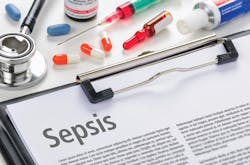New requirements and technologies improve sepsis management and outcomes
Sepsis is a life-threatening dysregulated host response to infection that may lead to organ failure and even death. Years ago, sepsis was a life or death medical condition and it remains so today, even as advances in patient care and medicine continue to evolve. Faster recognition of the signs and symptoms of sepsis is vitally important to help ensure patients receive treatment as early and as quickly as possible to help improve a patient’s odds for survival. As hospitals spend more than $27 billion on sepsis each year in terms of extended length of stay, high readmission rates and antibiotics costs,1 new requirements and new technologies now available are welcome additions to aid physicians in modernizing and strengthening sepsis best practices.
As sepsis is secondary to preceding conditions like pneumonia, increased vigilance during notable periods such as flu season is warranted. The signs and symptoms of sepsis are very dramatic and can include but are not limited to high fever, lethargy, lack of appetite, extreme fatigue and shortness of breath. For patients, the challenge is to recognize these indications as sepsis symptoms and seek medical attention immediately.
For medical professionals, the challenge is to correctly identify a patient’s infection and name it so the proper treatment can begin without delay. It is important for physicians to continue increasing awareness and communicating the telltale warning signs and indications of sepsis among the general population. A persistent fever coupled with extreme lethargy and vomiting should trigger patients and their families to seek medical attention at their nearest Emergency Department facility.
As many as 80 percent of sepsis deaths could be prevented with rapid diagnostics and appropriate treatment.2 Time is the most critical factor in determining survival, which is why a best practice approach to managing septic patients is essential. Treating patients during the first hour of hypotension onset gives patients the best odds for survival. However, a patient’s mortality rate increases for each hour appropriate antimicrobial therapy is delayed.2 The survival rate with antibiotics at hours five to six post documented hypotension is 42 percent, and plummets to just 25.4 percent at hours nine to 12.3
Diagnosis of Suspected Infection
The qSOFA score is a bedside prompt that may identify patients with suspected infection who are at greater risk for a poor outcome outside the intensive care unit (ICU). It uses three criteria, assigning one point for low blood pressure (SBP≤100 mmHg), high respiratory rate (≥22 breaths per min) or altered mentation (Glasgow coma scale<15). With scores ranging from zero to three points, two or more qSOFA points near the onset of infection are not only associated with a greater risk of death or prolonged ICU stay but also with patients who may be septic. This is why the Third International Consensus Definitions for Sepsis recommends qSOFA as a simple prompt to identify infected patients outside the ICU who are likely to be septic.
In addition to qSOFA and a physical examination, the most important aspect of properly and quickly diagnosing sepsis is through the use of diagnostic tests. Blood work, urine tests, white blood cell counts, lactate, C-reactive protein (CRP) and procalcitonin (PCT) tests enable physicians to accurately determine the presence or absence of a bacterial infection. Following these measures with blood cultures, diagnostic testing and imaging allows physicians to identify the microorganism causing the infection and gain a bigger picture of what the patient is experiencing.
When it comes to designing sepsis protocols, physicians have a few successful best practices to reference. In addition to the Surviving Sepsis Campaign treatment bundle, medical professionals can look to the group at the University of Nebraska which adds a procalcitonin-guided protocol to enable physicians to quickly identify if an infection is bacterial or viral, as well as help them quickly deescalate the use of antibiotics.
In February 2017, the FDA cleared the expanded use of the VIDAS B•R•A•H•M•S PCT assay to help healthcare providers determine if antibiotic treatment should be started or stopped in patients with lower respiratory tract infections, such as community-acquired pneumonia, and when to stop antibiotics in patients with sepsis. As a result of FDA’s decision, more hospitals are aware of this new technological tool that can be used not only in sepsis protocols but in Antimicrobial Stewardship Programs (ASP) as well to strengthen such initiatives.
ASP and Sepsis Protocols
From a best practice perspective, a sepsis protocol could be seamlessly integrated with an institution’s ASP. As CMS has mandated U.S. hospitals to have ASPs in place by March 30, 2020, to meet reimbursement guidelines, ASP committees could examine a sepsis protocol from a multidisciplinary approach. If it makes sense for an institution to do so, aligning the two would be an excellent idea. As ASPs focus on curtailing any overuse or misuse of antimicrobials to help curb the spread of antimicrobial-resistant infections, ceasing the use of powerful antimicrobials in a patient with sepsis as soon as possible helps patients experience better outcomes while lowering their risk of resistant infections. PCT testing supports the goals of both sepsis protocols and ASPs by determining if an infection is bacterial or viral, as well as indicating when antimicrobials can be scaled back.
Another technological advancement that may help strengthen hospitals’ sepsis protocols is the availability of data analytics tools in healthcare. Data analytics platforms like AGILIST consolidate multiple test results across disparate platforms to give physicians access to rich data in real-time for more informed decision-making. Having a holistic view of infectious disease management through data analytics could allow medical professionals to customize treatment protocols to sepsis patients’ individual needs, maximizing the limited time window for sepsis treatment, and it may also allow for physicians to benchmark their own performance in antibiotic use.
Within the past few years, the medical community has been able to identify sepsis much sooner and manage it much faster. This is vitally important as every minute counts with sepsis, because the longer it takes to administer the antibiotic, the harder it becomes to achieve recovery. In septic shock, mortality increases 7 percent for every hour delay in initiation of antibiotics, so early recognition of sepsis and initiation of appropriate antibiotics can improve the chances for survival.3
As medical technology continues to advance, it is vital to continuously modernize sepsis protocols. To do so, look at the technology utilized in your institution and compare it to what is newly available, such as diagnostic tests that quicken the determination of sepsis and the underlying infection or data analytics tools that empower physicians with real-time information for more targeted treatment decisions. Incorporate qSOFA score measurements and imaging along with the success protocols of others, such as University of Nebraska’s inclusion of procalcitonin-guided therapy. Also establish a multidisciplinary team, similar to an ASP team, comprised of a laboratory director, hospital pharmacist and an ICU physician to best manage sepsis patients’ care. Through continuous improvement of sepsis protocols, medical professionals can improve sepsis patients’ odds and outcomes.
References:
- Rhee C, Dantes R, Epstein L, et al. Incidence and Trends of Sepsis in U.S. Hospitals Using Clinical vs Claims Data, 2009-2014. JAMA. 2017;318(13):1241. doi:10.1001/jama.13836.
- Zanotti-Cavazzoni S. Duration of hypotension before initiation of effective antimicrobial therapy is the critical determinant of survival in human septic shock. Yearbook of Critical Care Medicine. 2007; 2007:187-188. doi:10.1016/s0734-3299(08)70339.
- Kumar A, Roberts D, Wood KE, et al. Duration of hypotension before initiation of effective antimicrobial therapy is the critical determinant of survival in human septic shock. Crit Care Med. 2006;34:1286.
About the Author

Mauricio A. Berdugo, MD, MPH
is the Director of Global Scientific & Medical Affairs at bioMérieux.
